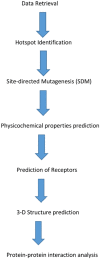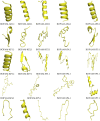Analytical Studies of Antimicrobial Peptides as Diagnostic Biomarkers for the Detection of Bacterial and Viral Pneumonia
- PMID: 35877356
- PMCID: PMC9311714
- DOI: 10.3390/bioengineering9070305
Analytical Studies of Antimicrobial Peptides as Diagnostic Biomarkers for the Detection of Bacterial and Viral Pneumonia
Abstract
Pneumonia remains one of the leading causes of infectious mortality and significant economic losses among our growing population. The lack of specific biomarkers for correct and timely diagnosis to detect patients' status is a bane towards initiating a proper treatment plan for the disease; thus, current biomarkers cannot distinguish between pneumonia and other associated conditions such as atherosclerotic plaques and human immunodeficiency virus (HIV). Antimicrobial peptides (AMPs) are potential candidates for detecting numerous illnesses due to their compensatory roles as theranostic molecules. This research sought to generate specific data for parental AMPs to identify viral and bacterial pneumonia pathogens using in silico technology. The parental antimicrobial peptides (AMPs) used in this work were AMPs discovered in our previous in silico analyses using the HMMER algorithm, which were used to generate derivative (mutated) AMPs that would bind with greater affinity, in order to detect the bacterial and viral receptors using an in silico site-directed mutagenesis approach. These AMPs' 3D structures were subsequently predicted and docked against receptor proteins. The result shows putative AMPs with the potential capacity to detect pneumonia caused by these pathogens through their binding precision with high sensitivity, accuracy, and specificity for possible use in point-of-care diagnosis. These peptides' tendency to detect receptor proteins of viral and bacterial pneumonia with precision justifies their use for differential diagnostics, in an attempt to reduce the problems of indiscriminate overuse, toxicity due to the wrong prescription, bacterial resistance, and the scarcity and high cost of existing pneumonia antibiotics.
Keywords: antimicrobial peptides; bacteria; databases; diagnostics; machine learning tool; receptors; viruses.
Conflict of interest statement
The authors declare no conflict of interest.
Figures






References
-
- Shin B., Kim S.-H., Yong S.J., Lee W.-Y., Park S., Lee S.J., Lee S.J., Lee M.K. Early readmission and mortality in acute exacerbation of chronic obstructive pulmonary disease with community-acquired pneumonia. Chronic Respir. Dis. 2018;16:1479972318809480. doi: 10.1177/1479972318809480. - DOI - PMC - PubMed
Grants and funding
LinkOut - more resources
Full Text Sources

